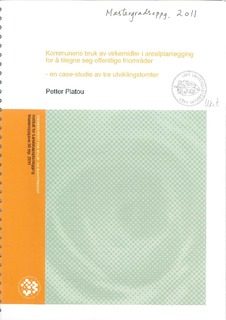Kommunens bruk av virkemidler i arealplanlegging for å tilegne seg offentlige friområder : en case-studie av tre utviklingstomter
Master thesis
Permanent lenke
http://hdl.handle.net/11250/188633Utgivelsesdato
2011-11-29Metadata
Vis full innførselSamlinger
- Master's theses (ILP) [763]
Sammendrag
Denne masteroppgaven omhandler eiendomsutvikling i tidlig fase, hvor jeg har hatt et
samarbeid med Realkapital Utvikling (RKU), som er et eiendomsutviklingsselskap i
DTZ-gruppen.
Jeg har gjennomført en case-studie av tre utvalgte tomter for RKU, både for å kartlegge
muligheter som er knyttet til de utvalgte eiendommene, men også for å belyse prinsipper
innenfor eiendomsutvikling via på forhånd fastsatte betraktningsperspektiv.
I alle tre casene jeg har undersøkt, har kommunen båndlagt de aktuelle eiendommene på
forskjellige måter. Det kan primært begrunnes med at grunneier har lagt ned virksomheten på
eiendommen, uten å initiere ny virksomhet eller utvikling samt at grunneier har forholdt seg
passiv til kommunens planarbeid. Dette medfører at eiendommene fremstår som meget
attraktive som offentlig friområder, og kommunen har avsatt eiendommene som nettopp dette
i kommuneplanens arealdel.
Kommunens vedtak om kommuneplanen er juridisk bindende og vedtaket kan ikke påklages,
så hvis det er en interessekonflikt mellom kommunens arealplanlegging og grunneiers plan
for eiendommen, må grunneier forsvare sine rettigheter under planarbeidet.
Grunneier i denne studien er et amerikansk selskap som ikke kjenner til det norske
plansystemet, og dermed heller ikke har forutsetninger for å forsvare sin eiendomsrett.
I to av tre caser konkluderer jeg med at en avhending av eiendommen til kommunen er det
beste alternativet. Dette er grunnet i at kommunen i begge tilfellene har planlagt eiendommen
som offentlig friområde i 7 år, og har med det forringet mulighetene for utvikling og dermed
også verdien av eiendommen såpass mye at andre alternativer ikke er regningssvarende.
Denne masteroppgaven belyser hvordan kommunen på forskjellige måter benytter seg av sin
reguleringsmyndighet til å tilegne seg offentlige friområder. Samtidig understreker den
viktigheten av å følge med på kommunens planlegging, hvis man har en eiendomsrett å forsvare. This master thesis covers real estate development at an early stage. I have conducted
feasibility studies of three properties with different locations in Norway, all of them to define
maximum value of potential and form a strategy of execution.
Throughout this process, I have cooperated with Realkapital Utvikling (RKU), a real estate
development firm, which is a part of DTZ Norway. RKU has provided me with case-material,
in addition to support and guiding.
The three properties I have studied are designated to be public recreational areas in the
municipal plan, which have made me study the planning process and mechanisms that
governs it thoroughly.
The municipal plan is legally binding and the decision can not be appealed, so if there is a
conflict of interest between the Municipality’s planning of land use and the landowner's plans
for the property, the landowner must defend his or hers right during the planning process.
The landowner in this thesis is an American company that does not know the Norwegian
planning system, and thus has remained indifferent to the Municipality’s planning of land-use.
In two of the three cases I have studied, I conclude that a disposal of the property to the
municipality is the best option. This is due to the fact that in both cases the municipality has
planned the property as a public recreational area for 7 years and has by that degraded the
opportunities for development and thus the value of the property so much that other
alternatives are not profitable.
This thesis sheds light on how the municipality in various ways can make use of its regulatory
authority to acquire public recreational areas, and it also emphasize the importance of
monitoring municipal planning, if one has real estate to defend.
